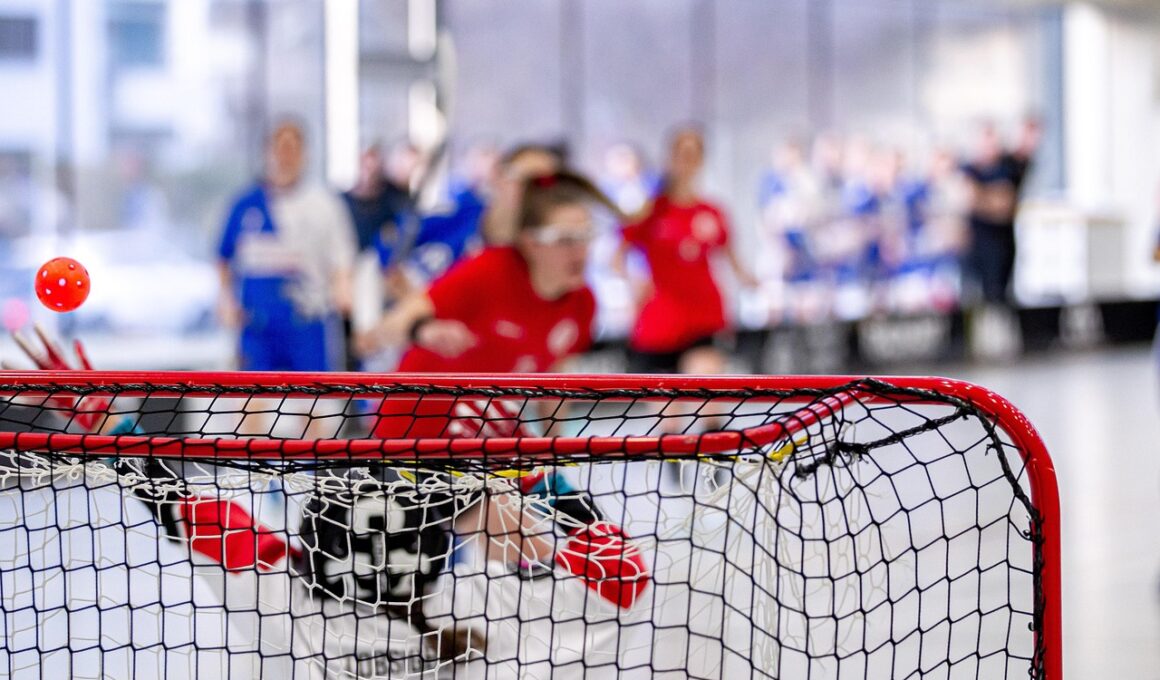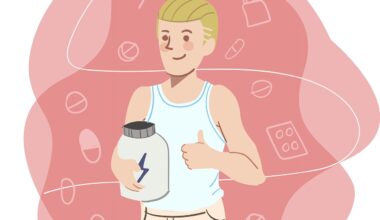Comparing Training Methods Between Floorball and Ice Hockey
Floorball and ice hockey are both exhilarating team sports that place high demands on athletes. Their training methods, however, reflect unique aspects of each sport. In floorball, training typically emphasizes agility, speed, and quick decision-making. Techniques such as small-sided games and targeted drills are fundamental. Players often engage in high-intensity interval training, which enhances aerobic and anaerobic fitness. In contrast, ice hockey training prioritizes strength and powerful skating techniques. Weight training, plyometrics, and skating drills are essential components of an ice hockey athlete’s regimen. With ice hockey, athletes must maintain endurance while ensuring their skating skills remain sharp. Additionally, both sports share similar goals related to teamwork and communication principles, serving to develop cohesiveness on the court or rink. Analyzing these distinct yet overlapping training regimens can help coaches tailor their strategies to enhance overall performance. As each sport continues to evolve, understanding different training methodologies can lead to more effective preparations for competitive play and enduring athletic success.
When examining floorball, players must often focus on cardiovascular fitness and technical skills crucial for handling the ball. Drills typically include ball control exercises and fast-paced scrimmages designed to imitate gameplay situations. These activities build a strong foundation for individual skills while emphasizing teamwork. In particular, players are trained to anticipate opponents’ movements and react quickly during matches. Improving offensive and defensive strategies is essential for building player acumen in this fast-paced environment. On the other hand, ice hockey players invest significant time mastering stickhandling, shooting techniques, and intricate tactical plays. Alongside traditional cardio workouts, hope to develop exceptional balance and coordination on ice. Many ice hockey practices involve extended periods of skating drills that promote endurance and strength. Consequently, the training regimens for both sports encourage strong communication among teammates, fostering unity on the court or rink. By integrating variations in training reports from these two sports, athletes can attain diverse skill sets that ultimately enhance their overall performance. The intersection of their training techniques may lead to new strategies that improve efficiency and effectiveness in both floorball and ice hockey.
Physical Conditioning Techniques
Physical conditioning is a vital aspect of training for both floorball and ice hockey, facilitating the development of players’ physical capabilities. In floorball, conditioning regimens frequently incorporate agility drills and speed work to help players navigate their environment efficiently. These drills may include lateral movement exercises, sprints, and plyometric jumps designed to enhance an athlete’s explosive power. Developing muscle memory enables players to react intuitively during competitions, crucial for successfully attacking or defending against opponents. Alternatively, ice hockey players typically incorporate strength training into their conditioning routines to improve explosive speed and overall power. Focused weight training sessions often involve compound movements like squats and deadlifts to develop powerful leg muscles essential for skating bursts. Conditioning for ice hockey can also include cardiovascular training through activities such as running, cycling, or even swimming to maintain peak stamina levels. Although variations exist between the two sports, each conditioning approach aims to foster physical attributes necessary for thriving in demanding game situations. Players who successfully blend these physical training programs can improve performance across both floorball and ice hockey.
In terms of practice frequency and duration, both sports showcase varying approaches due to their specific demands. Floorball training sessions typically occur multiple times a week with each session lasting around 60-90 minutes. This frequency allows players to maintain peak physical condition and develop technical skills efficiently. During these sessions, emphasis is placed not only on individual skill development but on team tactics as well. Conversely, ice hockey training can demand more prolonged and rigorous sessions because of its aggressive nature. Typically, ice hockey practices may last two hours or longer, focusing on fundamental skills, scrimmaging, and strategy development. The increased intensity often translates to longer recovery periods. Floorball, while still demanding, usually requires less recovery time due to its relative lack of physical contact compared to ice hockey. Consequently, players in both sports must effectively manage their energy levels and recovery strategies to reach optimal performance during games and competitions. By understanding these distinctions, athletes can better tailor their training sessions to maximize individual and team success on the court or rink.
Technical Skill Development
Technical skill development plays an equally crucial role in both floorball and ice hockey training routines. In floorball, players are taught how to master various techniques related to passing, shooting, and dribbling. Frequent practice of these foundational skills encourages seamless collaboration within teams, ultimately facilitating fluid gameplay. Players often participate in specialized drills aimed at enhancing shooting accuracy and passing precision, which are essential for executing game strategies effectively. Meanwhile, ice hockey’s technical skill development focuses heavily on skating techniques, puck control, and shooting forms. Players must dedicate substantial practice time to mastering tight turns and explosive starts to emerge victorious in on-ice battles. Specialized shooting drills target wrist shots, slap shots, and backhand efforts, ensuring well-rounded offensive capabilities. Additionally, the use of video analysis has become an increasingly common tool for both sports, providing actionable feedback to athletes regarding their technique and positioning. Athletes who excel in mastering the technical aspects of their respective sports are well-equipped to make effective decisions during competitive play. The commitment to refining technical skills can lead to significant performance improvements and ultimately drive competitive success.
Nutrition and recovery are integral components of training regimes for both floorball and ice hockey athletes. Players in both sports must prioritize proper nutrition to fuel their bodies, enabling them to perform at high levels during games. Floorball players often emphasize consuming carbohydrates to sustain energy levels during their shorter, fast-paced matches. Additionally, adequate hydration is essential to maintaining performance and preventing fatigue. On the flip side, ice hockey players tend to require higher caloric intake due to extended practice sessions and increased physical exertion. Consuming a balanced diet rich in proteins and healthy fats helps facilitate muscle recovery post-workout, a factor critical to long-term development. Recovery practices, such as stretching and rest days, are similarly crucial for both athletes. These strategies contribute to muscle repair and injury prevention, ensuring players remain competitive throughout the season. Establishing tailored dietary plans that meet both sports’ requirements can maximize performance and promote overall health. By recognizing the significance of nutrition and recovery, players in floorball and ice hockey can unlock their full potential on the court and rink.
Conclusion: Bridging Training Approaches
In conclusion, while floorball and ice hockey are distinct sports with unique characteristics, there’s a shared foundation in training methodologies. Both sports emphasize technical skill development, physical conditioning, and teamwork, which support athlete performance across different settings. By recognizing the nuances of their training approaches, players and coaches can effectively cross-train to improve their overall athleticism. This blending of techniques may lead to enhanced agility, strength, and tactical awareness across both sports. For instance, incorporating ice hockey’s strength training into floorball practice can offer players powerful on-court capabilities, while floorball’s emphasis on speed can provide ice hockey athletes with a competitive edge on the ice. Promoting an exchange of training insights can enrich the development of players involved in either sport. Moreover, understanding and sharing best practices will inevitably contribute to the evolution of training strategies designed to benefit athletes in the future. Ultimately, developing comprehensive knowledge of these methods may help refine training protocols that foster success in floorball, ice hockey, and beyond.
This concluding summary encapsulates the examination of training methodologies in both floorball and ice hockey. Athletes from both sports can draw valuable insights to enhance their performance through effective drills and conditioning strategies. By collaborating and sharing knowledge, players can diversify their skill sets, leading to improved overall performance. Establishing a comprehensive training regime that incorporates the best practices from both sports prepares athletes for mixed competition scenarios. Through rigorous physical and technical training, individuals involved in floorball and ice hockey will be poised to face evolving game challenges. Optimizing nutrition and recovery practices is vital for maintaining peak performance levels during competitive seasons. Overall, the comparison of training methods sheds light on how diverse approaches can be blended to create well-rounded athletes. Strengthening cross-discipline understanding can elevate the game, making athletes more adaptable and resilient. Identifying unique aspects within targeted training will undoubtedly provide an advantage in both sports. Thus, exploring innovations in floorball and ice hockey training presents an effective pathway toward advancing athletic aptitude for current and future generations.


